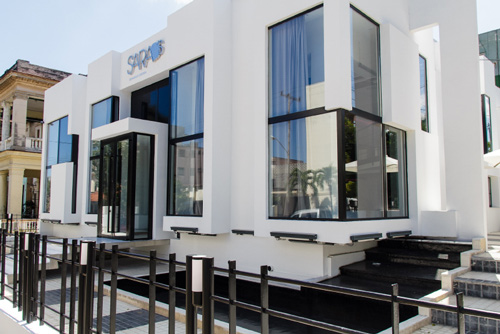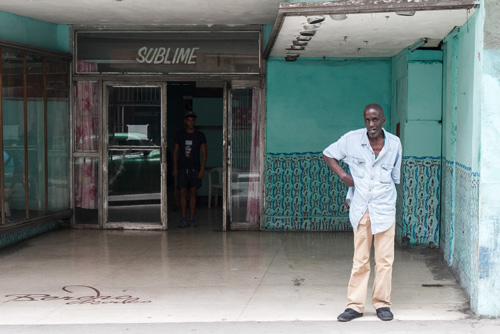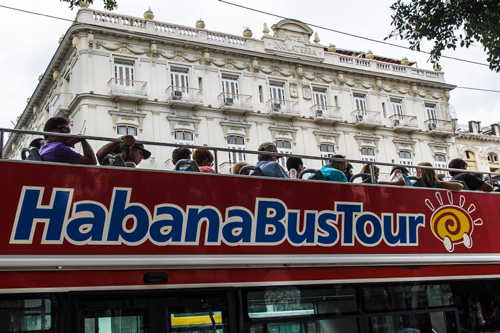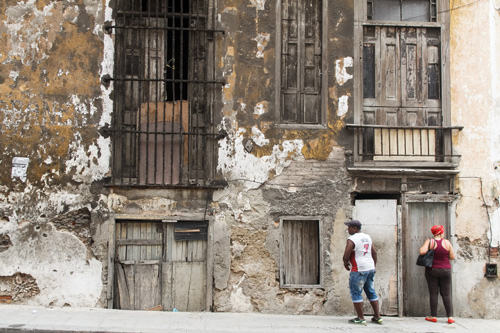Do Cuba’s Economic Reforms Imply Inequality Will Grow?

HAVANA TIMES — Inequalities among Cubans are becoming increasingly evident. A quick glance at the state of cities and towns clearly reveals who has the greater purchasing power and who barely manages to get by on their monthly wages. It also makes clear who can’t even manage to make ends meet without (inadequate) State aid.
The implementation of economic and political reforms – whose pace some consider slow and the government appropriate – leads to situations in which large groups of citizens are being deprived of the benefits of the country’s liberalization and clearly have less money to eat, dress and satisfy the most basic human needs.
Within this context, a growing number of Cuban intellectuals are insisting on the importance of encouraging public debate, in order to define the extent to which Cuban society is willing to accept these social differences. It is not a minor issue, as it presupposes an attempt to rethink the country people want, after being in the front-lines of efforts to try and build a fair society that offers everyone the same opportunities and resources, for more the fifty years.

The debate is impelled by the Cuba Posible (“A Possible Cuba”) project is now joined by economist Julio Carranza, former deputy director of the Center for the Study of the Americas (CEA) and co-author of the book Cuba: la reestructuración de la economía (una propuesta para el debate) (“Cuba: The Restructuring of the Economy – A Proposal for Debate”), published in 1995 – the expanded outcome of a report presented to the Cuban government in 1994, a report that was clearly dismissed at the time.
“In my opinion, there isn’t a single immediate future scenario for Cuba that does not involve greater economic differences in comparison to those that the Cuban revolution has sought, historically,” says Carranza, who wishes to see the “political courage needed” to acknowledge this reality.
“The problem, the greatest challenge, is how to conceive (both in political theory and practice) those inevitable differences, and what its limits ought to be. Every revolution is maximalist in its first stages, which is where its strength lies to a great extent. Later, existing conditions impose limits, greater rationality and a number of “steps back.” Then, the challenge becomes deciding what to preserve, how to do it, in what direction to head, what horizons to set for ourselves,” he notes.
 For Carranza, recent history reveals a number of policies which, far from stimulating economic growth, promoted a kind of “downward levelling,” reason enough not to repeat them in this new exploratory process, which no one yet knows where it will lead. “The inevitable income differences must be assumed as part of the economic model the country needs and be incorporated into the social dynamic in general, but such differences should not be extreme or lead to exclusion and marginality,” he underscores.
For Carranza, recent history reveals a number of policies which, far from stimulating economic growth, promoted a kind of “downward levelling,” reason enough not to repeat them in this new exploratory process, which no one yet knows where it will lead. “The inevitable income differences must be assumed as part of the economic model the country needs and be incorporated into the social dynamic in general, but such differences should not be extreme or lead to exclusion and marginality,” he underscores.
The economist expounds on a number of conditions which he believes must be preserved, in spite of the changes to Cuba’s socio-political system, provided the aim continues to be a fair society. In his opinion, the sectors based on fundamental social rights (such as education, health and social security) should continue to be based on equitable, free and universal, as they have been to date.
“Private ownership over the means of production, a novel and necessary factor of the current economic reforms, must have a clear extra-economic limit that can prevent the spread of private accumulation in the fundamental means of production (…) these must continue to be socially owned and managed,” the expert says, adding: “(…) foreign investment, crucial in terms of the capital, technology and markets it supplies – must be incorporated under adequate guarantees and for the purposes of securing profit, but also under State and social regulations that limit the impact of factors that run contrary to national development interests.”
With these suggestions, Carranza is in line with the national consensus that has been expressed to date: urgent reforms but without a loss of sovereignty and without traumatic measures, reforms that preserve what can be saved and, at the same time, undo the knots that keep individual and social initiative tied hand and foot. In short, to define and make concrete the slogan of “prosperous and sustainable socialism.”

“Socialism is not an egalitarian society, but it is the most egalitarian society history has known. The market cannot be suppressed by decree,” he points out.
Convinced that a model that brings about better social distribution of wealth is desirable for his country, Carranza recalls a number of concepts he made public in 1995, as a member of the now defunct CEA team.
“The defense of ‘egalitarianism,’ without properly understanding its meaning, its historical conditions and limitations may be a comfortable stance for certain political positions, but it is not suited to any possible scenario in Cuba in the immediate and not-so-near future. The challenge should not lead us to paralyze changes in defense of simple ‘egalitarianism,’ that is to say, to adopt a fatuous radicalism that leads to nothing. The challenge consists in making the change more dynamic while retaining the greatest levels of social justice and equality possible, without making concessions to the market and profits at the expense of society. We should also not demand a level of economic equality that is possible only in the Gospel or the utopias described in certain books, never in the reality and under the challenges the country faces today.”
—–
Photos: Juan Suarez

I had few problems with material when I built houses for Michel and Angelica in Niquero – Granma. They were built on family property and each one had a labour / material cost CUC $ 5000.00
I am retired from the forest industry but my two oldest sons are still in the industry. With enough time and money we can teach Cubans how to make forest products from trees. We sell a lot of lumber to the southern states including Florida – Si !!!
My email :::
[email protected]
They can’t even saw their own logs – hence the shortage of wood in Cuba. If trying to do formwork for concrete construction the poor folks in Cuba have to gather together any old wood they can find. To make furniture they have to re-cycle old wood. Cubans do not lack the skills or abilities, they lack the basic materials controlled by the regime.
A senior lumber worker in B.C. costs out at Ca. $ 80.0 an hour. I think it might be better to ship logs to Cuba and have them do the sawing – see the point ?
Result of the NAFTA agreement made by the Progressive Conservative government of Brian Mulroney and condemned by the Liberal Party of Canada. Remember also, that Canada is the USA’s largest trading partner so the trade is beneficial to both countries.
The Canadian GDP would be very low if we had no trade with the USA. Nearly of of my wages / profit when I was working came from sales to the USA !
Sweden is held up as an example of socialism that works, but it has a very different system than that of Cuba. Sweden has produced a large number of very successful entrepreneurs, with many privately owned corporations and businesses. They have relatively high tax rates in Sweden and the government spends a large proportion of its budget on social programs. Corruption, in government and in business is among the lowest in the world.
Finally, Sweden is still a liberal democracy with regular free elections between multiple parties. Swedes also enjoy the full suite of rights and freedoms denied to Cubans. Although called “socialist” by Americans, Sweden has also elected conservative right-of-centre governments.
In short: Cuba has a long way to go before it will ever approach anything like Sweden.
Reads like a summary of the history of the Spanish in Cuba from 1492 until 1898.
Brisas is operated by Gaviota – GAESA! – just to help your research! Have a good time.
Care to put a date on when Cubans who work the hardest and smartest will be rewarded with a very good quality of life (similar to Canadians).
Currently the GDP in Canada is more than nine times that of Cuba. So what is your guess at “very shortly”.
The difference is that people aren’t 500 times taller. Also quite often the richest aren’t those that work hardest or have the greatest abilities. Often they don’t work at all and contribute nothing to society.
I think a Swedish-style form of socialism is the closest existing model that has been relatively successful worth emulating in a post-Castro Cuba. Here are the stumbling blocks: Cuba needs immense capital investment in its infrastructure for the Swedish model to work. Swedes are culturally thrifty and have a high savings rate. Cubans, for a variety of reasons, spend everything they have or can borrow. Modern infrastructure and high savings are critical to making the Swedish model work.
I lived in Sweden many years ago and am currently vactioning there. Incomes are not equal here, but they are relative to the my home, the United States. Medical care, education and infrastructure are provided by the government. For example, the city of Stockholm provides wholesale Internet connectivity and allows private companies to compete using that infrastructure. This has been successful — http://cis471.blogspot.se/2014/06/stockholm-19-years-of-municipal.html — the people have low cost service and the city makes money.
A few days ago, I rode in a cab from the Copenhagen airport to the city. The driver told me that he was about to leave on a 4 week camping trip in Croatia with his family — that could not happen in the US. Most stores are closed on Sundays and Swedes typically take a month long summer vacation and have 16 paid holidays.
Sweden is much better developed than Cuba, but the population (around 9,5 million) is comparable and Cuba is well educated and has around 1.8 relatively well off ex-pats nearby in the US. (Not to mention the climate :-). Could Cuba set its sites on a Sweden-like economy?
In Canada those that work the hardest and smartest are rewarded with a very good quality of life. This will happen in Cuba very shortly.
I leave in three weeks for my 89th research trip to Cuba – Brisas Guardavalaca and Marea Del Portillo resorts.
Very well stated. The pursuit of just social sharing of opportunity does not mean equal outcome. It was always an absurd proposition that society needs equality in everything. Why ? We do not all have the same height, physical ability or mental ability. It is natural that differences exist, that we embrace and accept each other’s differences.
Does every man need to earn the same wage for fairness ? No. Not rewarding effort is precisely the definition of unfairness. So if not equal outcome, then to what effort should the state pursue. Well equality of access to compete on merit, to protect the most vulnerable, to assure fairness of compensation for effort. The best systems involve check and balances to bring about this prevailing model.
The American left is a pathetic example of using people’s emotional weakness to self interest. While they wail against 300 or so CEO’s out of a population of 330 million, they do little to help millions rise through competive system that rewards effort. In the mean time Cuba is unleashing a wave of new interprueners, targeting state assistance and building a culture of nothing is given, all is earned.
I have researched Cuba since 1993 ( 88 trips to Cuba ) and there is inequality. This factures around those who receive $$$ from outside of Cuba.